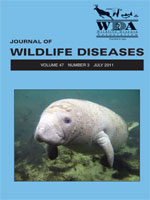Combinations of medetomidine and ketamine were evaluated in free-ranging, wild Norwegian reindeer (Rangifer tarandus tarandus) as part of a reintroduction program in southwestern Norway in November 1995 and November 1996. The drugs were administered by dart from a helicopter. The mean (SD) effective immobilizing doses for 29 adults (8 males, 21 females) were 0.21 (0.04) mg medetomidine/kg and 1.0 (0.2) mg ketamine/ kg based on estimated body mass. There was no significant difference in mean induction times between males and females. However, animals with optimal hits (shoulder or thigh muscles; n=16) had a significantly shorter (P<0.05) mean induction time than did animals with suboptimal hits (abdomen or flank; n=13), 5.6 (2.2) min and 11.1 (4.7) min, respectively. Inductions were calm, and immobilized animals were maintained in sternal recumbency. Clinical side effects included hypoxemia and hyperthermia in most animals. For reversal, all animals received 5 mg atipamezole per mg medetomidine, half intravenously and half intramuscularly, and the mean (SD) time to standing was 3.7 (3.6) min.
How to translate text using browser tools
1 July 2011
Effective Immobilizing Doses of Medetomidine-Ketamine in Free-ranging, Wild Norwegian Reindeer (Rangifer tarandus tarandus)
Jon M. Arnemo,
Alina L. Evans,
Andrea L. Miller,
Øystein Os
ACCESS THE FULL ARTICLE

Journal of Wildlife Diseases
Vol. 47 • No. 3
July 2011
Vol. 47 • No. 3
July 2011
Atipamezole
immobilization
ketamine
medetomidine
Rangifer tarandus
reindeer




